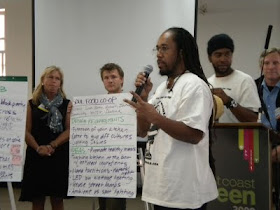Last week I was at West Coast Green, a green building and design conference in San Francisco. Besides speakers on all sorts of green technologies, standards and legislation, there were two exhibit rooms of companies with green products, and a special section called the Innovation Pipeline with new and upcoming products. One of the more interesting displays was a portable, on-demand housing unit that's designed to shelter people in the wake of a disaster like Hurricane Katrina, and be zero-impact, too. It's an impressive unit that can be shipped anywhere in the world in a shipping container, and set up in two hours with unskilled people, and includes solar panels and water treatment. But even with a product like that, never mind expensive solar-power roof tiles or fancy countertops, it's easy to lose sight of people in the equation and just be looking at costs and carbon.
That's why I was delighted to find one session titled Creating Social and Sustainable Economic Development in West Oakland, sponsored by the Home Depot Foundation. People with a wide variety of backgrounds came together with Ecocity Builders to brainstorm ideas for land use in West Oakland. But the kicker was that we weren't designing in a vacuum. People from Village Bottoms and A Black New World joined the discussion, and told us what their priorities and visions for the area were. I knew a tiny bit about the area since I'd worked on some Habitat for Humanity houses nearby, and been to City Slicker Farms, but mostly we knew nothing but what a few briefs told us about the former Phoenix Iron Works site. So having residents there to work alongside was amazing and inspiring. We heard about Village Bottoms Farms, about the burgeoning artist community, and about the history of the area.
Admittedly there was a limited amount we could do in 2 hours, but it was a great session, and a reminder that people are the most important part of the equation for any urban planning.



Absolutely! Engaging on many levels.
ReplyDelete-Cameron